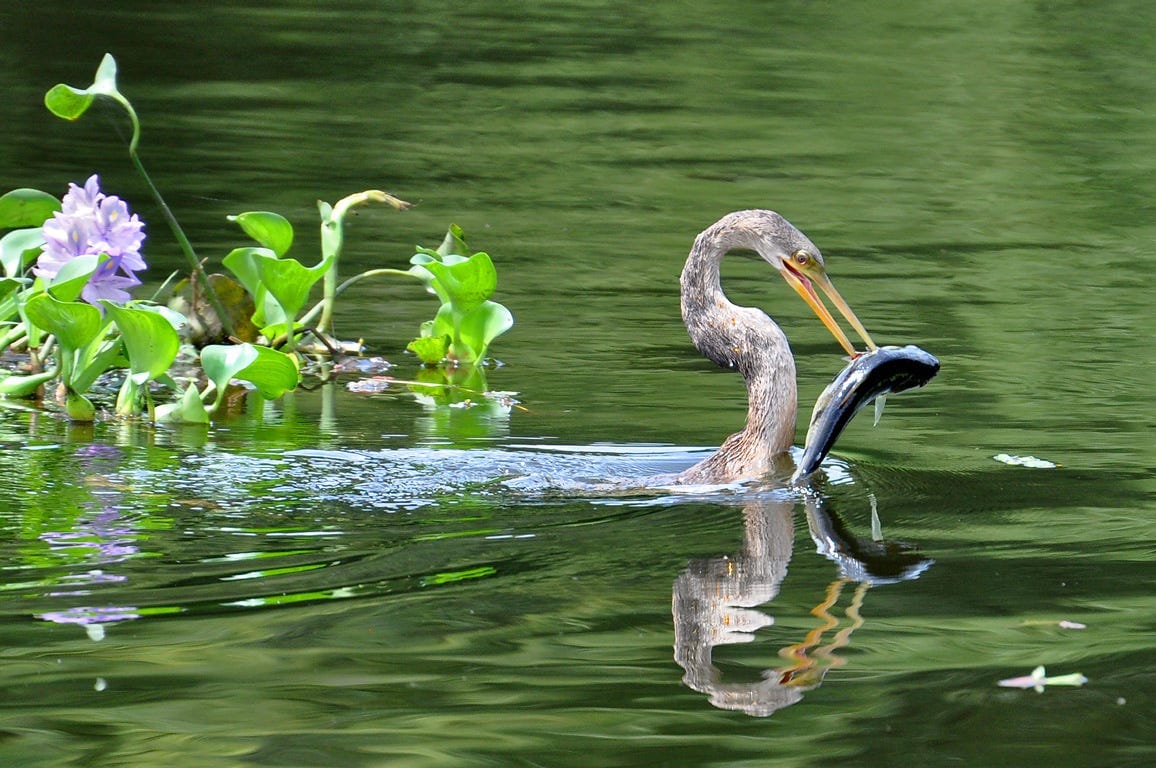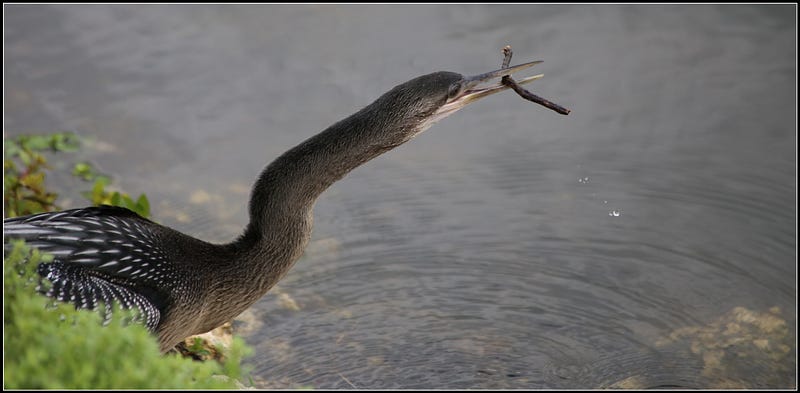
The anhinga, Anhinga anhinga, also known as the snake bird (because of its long snake-like neck) or water turkey (because of the large fan shape its tail makes resembling that of a turkey), is a common sight here in Florida. Unlike most waterfowl, which use a special gland to waterproof their feathers, the anhinga must dry its feathers using sunlight. This leads to their iconic spread-wing posture, something they share with the closely related cormorants. I’ve already discussed this behavior earlier in one of my very first stories.
This time, I would like to examine something a bit different, an activity I suspect is related in some way to their feeding. As you can see from the photo above, anhingas are primarily piscivorous, eating fish, which they spear using their sharp beak (in fact, one way to differentiate an anhinga from a cormorant is its straight beak, lacking the hook on the end present in most cormorant species like the double crested cormorant, Phalacrocorax auritus, pictured below).

Of course, while this strategy is efficient, it does pose several problems for the anhinga. Firstly, because birds have no teeth, it cannot chew in order to break down its prey into more manageable bits. It also cannot tear off smaller chunks like a hawk or other bird of prey, its beak structure not being suited for such a task. Thus, it must swallow its prey whole, preferably head first (the latter minimizes the chances of extremities getting caught in the throat on the way down. To do this, the anhinga must remove the fish from its bill and reposition it. This introduces another set of challenges. Birds do not have hands or any kind of forearm appendage suited for grasping because these have become wings instead. An anhinga’s feet are also not useful for this, as they are webbed to aid in swimming. How do they manage? Quite elegantly, in fact, as the video below demonstrates.
Anhinga Stabbing and Eating a Fish by jcanderson11, YouTube
So, at this point you are probably wondering what any of this has to do with the subject of play. In addition to the playful nature of ravens, the thing that cemented my decision to cover this topic for Season 6 was a series of observations of anhingas I made this past Spring. These occurred from my parents’ lanai, which looks out onto a small pond, the same pond where I saw the sunning heron in the early story linked above. The next pond over contains a series of mangrove islands that several different species of water birds, including anhingas, used as a nightly roosting spot as well as a rookery for raising their young.
During the day, the anhingas would frequently congregate in a nearby pine tree or on the shore of the pond just beneath the lanai. One day, while visiting, I noticed that one of them was holding a stick in its beak, similar to the picture below. This in and of itself was not particularly remarkable, as we would frequently see individuals of multiple species collecting twigs to use for nesting materials. However, some motion caught my eye and I moved to get a closer look and confirm what I thought I had just seen. Indeed, my initial impression was confirmed as I could clearly see the bird throwing the stick into the air and then attempting to catch it again.

This was not some sort of aberrant behavior, either. I saw the same thing again on several occasions over the following weeks. Furthermore, I was able to locate a video of this interesting phenomenon. What could possibly be gained by an anhinga by playing catch with itself using a stick? Then I remembered their feeding method and the likely answer became clear to me. These individuals were practicing their fish hurling and beak manipulation techniques on sticks. Most likely, these were younger individuals that still needed to perfect their methods.
Anhinga Playing with a Stick by River, YouTube
This is the essence of play in the natural world. It allows an individual to develop important survival abilities in a consequence free (or at least consequence light) environment. This is a theme that we are going to see again and again as we proceed with more stories this season. Keep in mind that each of the play behaviors has likely developed over long periods of time so as to maximize evolutionary fitness, the ability to survive and reproduce. While these birds almost look like puppies playing fetch, remember that every aspect of it has some purpose. Play undertaken simply for enjoyment does exist, but it is much more rare. Even then, it can be difficult to separate the two concepts, as pleasure can be explained as a physiological reaction to the secretion of certain chemicals in the brain, which can also be potentially adaptive given the proper circumstances.
Next week, we’ll continue with another story connected to my earlier work. We’ll travel back in time again to my family visit to the Galápagos Islands and discuss a particularly playful individual encountered, and photographed by my brother. As always, if you enjoy my stories, please like and follow me and please share them with others who also have an appreciation for the natural world.